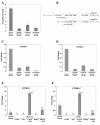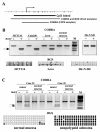The protein tyrosine phosphatase receptor type R gene is an early and frequent target of silencing in human colorectal tumorigenesis
- PMID: 20015382
- PMCID: PMC2801661
- DOI: 10.1186/1476-4598-8-124
The protein tyrosine phosphatase receptor type R gene is an early and frequent target of silencing in human colorectal tumorigenesis
Abstract
Background: Tumor development in the human colon is commonly accompanied by epigenetic changes, such as DNA methylation and chromatin modifications. These alterations result in significant, inheritable changes in gene expression that contribute to the selection of tumor cells with enhanced survival potential.
Results: A recent high-throughput gene expression analysis conducted by our group identified numerous genes whose transcription was markedly diminished in colorectal tumors. One of these, the protein-tyrosine phosphatase receptor type R (PTPRR) gene, was dramatically downregulated from the earliest stages of cellular transformation. Here, we show that levels of both major PTPRR transcript variants are markedly decreased (compared with normal mucosal levels) in precancerous and cancerous colorectal tumors, as well in colorectal cancer cell lines. The expression of the PTPRR-1 isoform was inactivated in colorectal cancer cells as a result of de novo CpG island methylation and enrichment of transcription-repressive histone-tail marks, mainly H3K27me3. De novo methylation of the PTPRR-1 transcription start site was demonstrated in 29/36 (80%) colorectal adenomas, 42/44 (95%) colorectal adenocarcinomas, and 8/8 (100%) liver metastases associated with the latter tumors.
Conclusions: Epigenetic downregulation of PTPRR seems to be an early alteration in colorectal cell transformation, which is maintained during the clonal selection associated with tumor progression. It may represent a preliminary step in the constitutive activation of the RAS/RAF/MAPK/ERK signalling, an effect that will later be consolidated by mutations in genes encoding key components of this pathway.
Figures



Similar articles
-
Re-expression of epigenetically silenced PTPRR by histone acetylation sensitizes RAS-mutant lung adenocarcinoma to SHP2 inhibition.Cell Mol Life Sci. 2024 Jan 28;81(1):64. doi: 10.1007/s00018-023-05034-w. Cell Mol Life Sci. 2024. PMID: 38280930 Free PMC article.
-
Protein tyrosine phosphatase receptor-like genes are frequently hypermethylated in sporadic colorectal cancer.J Hum Genet. 2013 Jan;58(1):11-5. doi: 10.1038/jhg.2012.119. Epub 2012 Oct 25. J Hum Genet. 2013. PMID: 23096495
-
Epigenetic silencing of PTPRR activates MAPK signaling, promotes metastasis and serves as a biomarker of invasive cervical cancer.Oncogene. 2013 Jan 3;32(1):15-26. doi: 10.1038/onc.2012.29. Epub 2012 Feb 13. Oncogene. 2013. PMID: 22330137
-
Epigenetic changes in colorectal cancer.Cancer Metastasis Rev. 2004 Jan-Jun;23(1-2):29-39. doi: 10.1023/a:1025806911782. Cancer Metastasis Rev. 2004. PMID: 15000147 Review.
-
Tyrosine phosphatases as a superfamily of tumor suppressors in colorectal cancer.Acta Biochim Pol. 2011;58(4):467-70. Epub 2011 Dec 6. Acta Biochim Pol. 2011. PMID: 22146137 Review.
Cited by
-
Downregulation of Protein Tyrosine Phosphatase Receptor Type R Accounts for the Progression of Hirschsprung Disease.Front Mol Neurosci. 2019 Apr 10;12:92. doi: 10.3389/fnmol.2019.00092. eCollection 2019. Front Mol Neurosci. 2019. PMID: 31024255 Free PMC article.
-
The proto CpG island methylator phenotype of sessile serrated adenomas/polyps.Epigenetics. 2018;13(10-11):1088-1105. doi: 10.1080/15592294.2018.1543504. Epub 2018 Nov 22. Epigenetics. 2018. PMID: 30398409 Free PMC article.
-
Early insights into the function of KIAA1199, a markedly overexpressed protein in human colorectal tumors.PLoS One. 2013 Jul 23;8(7):e69473. doi: 10.1371/journal.pone.0069473. Print 2013. PLoS One. 2013. PMID: 23936024 Free PMC article.
-
Weighted change-point method for detecting differential gene expression in breast cancer microarray data.PLoS One. 2012;7(1):e29860. doi: 10.1371/journal.pone.0029860. Epub 2012 Jan 20. PLoS One. 2012. PMID: 22276133 Free PMC article.
-
Genomic Characterization of TP53-Wild-Type Esophageal Carcinoma.Transl Oncol. 2019 Jan;12(1):154-161. doi: 10.1016/j.tranon.2018.09.007. Epub 2018 Oct 11. Transl Oncol. 2019. PMID: 30317074 Free PMC article.
References
Publication types
MeSH terms
Substances
Grants and funding
LinkOut - more resources
Full Text Sources
Medical
Research Materials
Miscellaneous

